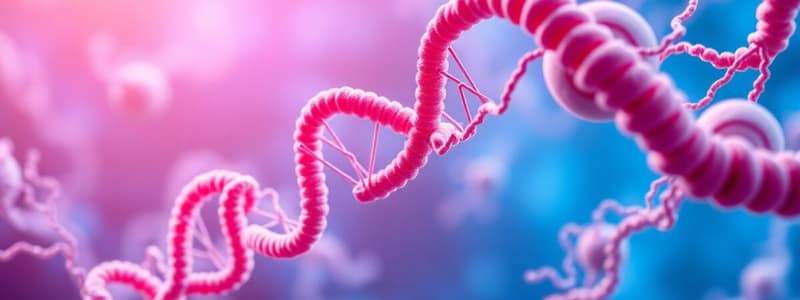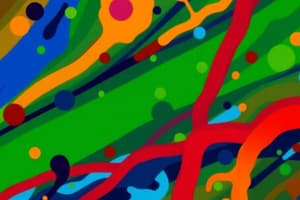Podcast
Questions and Answers
Quid significat verbum 'macronutrienti'?
Quid significat verbum 'macronutrienti'?
- Color in nutrimentis.
- Nutrimentum quod in parvis quantitatibus necessarium est.
- Elementum quod non est necessarium ad vitam.
- Nutrimentum magnae quantitatis necessarium. (correct)
Quod ex sequentibus non est typicum macronutrientium?
Quod ex sequentibus non est typicum macronutrientium?
- Carbohydrates
- Vitamini (correct)
- Grasa
- Proteina
Quis ex sequentibus non est bona founta macronutrientium?
Quis ex sequentibus non est bona founta macronutrientium?
- Cerealia
- Aqua (correct)
- Nuts
- Carnes
Quorum ex sequentibus maxime abundant carbohydrates?
Quorum ex sequentibus maxime abundant carbohydrates?
Quod macronutrientum praecipuum ad cellarum structuras necessarium est?
Quod macronutrientum praecipuum ad cellarum structuras necessarium est?
Quod in macronutrientes includitur, et non includitur in micronutrientes?
Quod in macronutrientes includitur, et non includitur in micronutrientes?
Quod ex sequentibus iuvat energiae productionem?
Quod ex sequentibus iuvat energiae productionem?
Quod sensu nutrimentorum praecipuum ad vitam valet?
Quod sensu nutrimentorum praecipuum ad vitam valet?
Quod macronutrimentum principale efficit energia corpus saepe?
Quod macronutrimentum principale efficit energia corpus saepe?
Quae horum macronutrimentorum non numerantur inter lipida?
Quae horum macronutrimentorum non numerantur inter lipida?
Quod est praecipuum munus proteinorum in corpore humano?
Quod est praecipuum munus proteinorum in corpore humano?
Quas inter condiciones considerandum est pro examinatione macronutrimentorum?
Quas inter condiciones considerandum est pro examinatione macronutrimentorum?
Quorum horum proteinorum optionum ex animalibus provenit?
Quorum horum proteinorum optionum ex animalibus provenit?
Quomodo lipida in corpore humano metabolizantur?
Quomodo lipida in corpore humano metabolizantur?
Quod macronutrimentum a corpore non exanimatur, sed intercellulariter reponitur?
Quod macronutrimentum a corpore non exanimatur, sed intercellulariter reponitur?
Quae res affectare potest metabolismum macronutrimentorum?
Quae res affectare potest metabolismum macronutrimentorum?
Flashcards
Macronutrientia
Macronutrientia
Substantiae nutritivae quae magnam partem energiae corporis provideri debent.
Carbohydrates
Carbohydrates
Macronutrientia quae praebent energiam celeriter ex carbonio, hydrogenio et oxygenio.
Lipida
Lipida
Macronutrientia quae praebent energiam longi temporis ex carbonio, hydrogenio et oxygenio.
Proteina
Proteina
Signup and view all the flashcards
Caloriae
Caloriae
Signup and view all the flashcards
Dieta
Dieta
Signup and view all the flashcards
Nutritio
Nutritio
Signup and view all the flashcards
Salus
Salus
Signup and view all the flashcards
Quid est macronutriens?
Quid est macronutriens?
Signup and view all the flashcards
Quae sunt quattuor macronutriens?
Quae sunt quattuor macronutriens?
Signup and view all the flashcards
Quid est carbohydrati?
Quid est carbohydrati?
Signup and view all the flashcards
Quid est proteineae?
Quid est proteineae?
Signup and view all the flashcards
Quid est pinguedines?
Quid est pinguedines?
Signup and view all the flashcards
Quid est aqua?
Quid est aqua?
Signup and view all the flashcards
Study Notes
Quiz Submissions - Test #1
- Question 1: Protein synthesis occurs in the rough endoplasmic reticulum.
- Question 2: Ribosomal RNA synthesis and ribosome production occur in the nucleolus, a structure within the nucleus.
- Question 3: The mitochondrion is the energy-generating organelle, possessing an inner and outer membrane.
- Question 4: Protein synthesis involves mRNA leaving the nucleus and traveling to the ribosomes for amino acid insertion via tRNA. Transcription is the reading of mRNA by ribosomes and the insertion of amino acids transported by tRNA.
- Question 5: Alkaline mucus is released by stomach cells during digestion.
- Question 6: Chief cells release pepsinogen and gastric lipase.
- Question 7: Pepsinogen is an inactive enzyme form secreted into the stomach that requires activation.
- Question 8: Secretin is a digestive hormone released by cells in the duodenum in response to acidic chyme in the small intestine promoting bicarbonate release from the pancreas.
- Question 9: Neuropeptide Y stimulates specialized cells in the stomach to release acid and intrinsic factor.
- Question 10: Cholecysokinin promotes the release of bile from the gallbladder and digestive enzymes from the pancreas.
- Question 11: The field that studies the influence of diet on gene expression in precancerous cells is nutrigenomics.
- Question 12: An example of epigenetic influence is seen when a pregnant woman with anorexia nervosa and low protein intake results in an infant with weight issues due to methylation influenced by the mother's and father's genes during pregnancy.
- Question 13: Maltose is a disaccharide composed of two glucose molecules.
- Question 14: Alpha-dextrinase breaks down x(1-6) branching bonds in starch.
- Question 15: GLUT2 is a dominant absorptive mechanism when glucose is present in low concentrations in the lumen after ingestion.
- Question 16: Fructose absorption is facilitated by GLUT5, an integral protein, via facilitative transport.
- Question 17: Absorbed carbohydrates enter the hepatic portal vein, delivering them to the liver.
- Question 18: Blood leaving the liver contains glucose with little to no galactose or fructose after a mixed carbohydrate meal.
- Question 19: Muscle and adipose tissue require insulin for glucose uptake.
- Question 20: GLUT4 is a glucose transporter that works with insulin.
- Question 21: Exercise-induced muscle movement promotes glucose transporter (GLUT) vesicle movement to the cell membrane.
- Question 22: Beta cells of the pancreas release insulin to reduce elevated blood glucose when increased above normal range.
- Question 23: White rice has the highest glycemic index.
- Question 24: Type 2 diabetes mellitus management involves a balanced diet and lifestyle rather than cortisol.
- Question 25: Glucokinase in liver cells is inhibited by glucose-6-phosphate, and glycogen is stored in muscle and adipose tissue.
- Question 26: The pentose monophosphate shunt occurs in the cytoplasm.
- Question 27: Allosteric regulation by ATP inhibits phosphofructokinase activity.
- Question 28: Glycogen synthase activation is a result of dephosphorylation.
- Question 29: Glycolysis is allosterically inhibited by ATP and citrate.
- Question 30: NADH and FADH2 are generated in the Krebs cycle, also known as the tricarboxylic acid cycle.
- Question 31: FADH2 transmits electrons to the electron transport chain, generating ATP
- Question 32: Gluconeogenesis uses amino acids into pyruvate and oxaloacetate to make glucose.
- Question 33: Dietary fiber is indigestible carbohydrates and lignin, which is a structural component in plants.
- Question 34: Fiber characteristics are fermentability, gel formation, stickiness, and viscosity.
- Question 35: Viscous fibers promote satiety due to gel formation in the gastrointestinal tract.
- Question 36: Fermentation of fermentable fibers primarily occurs in the large intestine; fibers themselves are fermented by bacteria rather than viruses.
- Question 37: Short-chain fatty acids produced from fiber fermentation serve as fuel for colonic cells. They improve colonic blood flow and enhance cell growth.
- Question 38: Viscous fibers, which produce gels, can reduce the risk of cardiovascular disease by lowering LDL cholesterol levels.
- Question 39: Ribose is an important product of the pentose phosphate pathway.
- Question 40: Probiotics are live microorganisms that promote health and provide nutrients for bacteria, and are found in cultures of yogurt
Studying That Suits You
Use AI to generate personalized quizzes and flashcards to suit your learning preferences.




